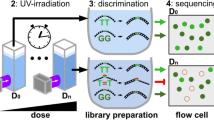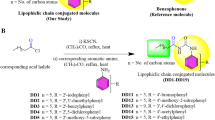Abstract
WE have used cells that were derived from individuals with xeroderma pigmentosum (XP) and are defective in excision repair1 to demonstrate the appearance of ultraviolet lesions in the DNA made after ultraviolet irradiation. Normal human and XP cells were irradiated and labelled with either 3H-thymidine or 32PO4 for 6–8 h, the label was removed, and the cells were further incubated for 18 h to allow for DNA chain elongation and joining of the short DNA segments synthesised after irradiation. The cells were then osmotically shocked, treated with a repair endonuclease contained in Micrococcus luteus extract for 5 min at 37° C and pH 8.0, and sedimented in 5–20% alkaline sucrose gradients. The enzymatic assay2 and the sedimentation procedure3 have been described elsewhere. Figure 1 shows that daughter DNA from irradiated and non-irradiated normal human cells contains no repair endonuclease-sensitive sites. This is expected because normal human cells excise and repair most of the pyrimidine dinners formed after ultraviolet irradiation4. Figure 2 shows that DNA synthesised by irradiated XP cells does contain repair endonuclease-sensitive sites, although the number appears to be small. Under our experimental conditions there is approximately one sensitive site for every fifteen to thirty-five dimers in the parental DNA5.
This is a preview of subscription content, access via your institution
Access options
Subscribe to this journal
Receive 51 print issues and online access
$199.00 per year
only $3.90 per issue
Buy this article
- Purchase on SpringerLink
- Instant access to full article PDF
Prices may be subject to local taxes which are calculated during checkout
Similar content being viewed by others
References
Cleaver, J. E., Nature, 218, 652 (1968).
Wilkins, R. J., Int. J. Radiat. Biol. (in the press).
Regan, J. D., Setlow, R. B., and Ley, R. D., Proc. natn. Acad. Sci. U.S.A., 68, 708 (1971).
Regan, J. D., Trosko, J. E., and Carrier, W. L., Biophys. J., 8, 319 (1968).
Setlow, R. B., Regan, J. D., German, J., and Carrier, W. L., Proc. natn. Acad. Sci. U.S.A., 68, 1035 (1969).
Rupp, W. D., and Howard-Flanders, P., J. molec. Biol., 31, 291 (1968).
Rupp, W. D., in Workshop on Repair Mechanisms in Mammalian Cells, Noordwijkerhout, The Netherlands, Abstract 1B.
Puck, T. T., Ann. N.Y. Acad. Sci., 171, 406 (1970).
Buhl, S. N., Stillman, R. M., Setlow, R. B., and Regan, J. D., Biophys. J., 12, 1183 (1972).
Buhl, S. N., Setlow, R. B., and Regan, J. D., Int. J. Radiat. Biol., 22, 417 (1972).
Siemens, H. W., and Kohn, E., Z. Indukt. Abstamm. Vererbungsl., 38, 1 (1925).
Carrier, W. L., and Setlow, R. B., J. Bact., 102, 178 (1970).
Paribok, V. P., and Tomilin, N. V., Nature new Biol., 230, 210 (1971).
Author information
Authors and Affiliations
Rights and permissions
About this article
Cite this article
BUHL, S., REGAN, J. Repair Endonuclease-sensitive Sites in Daughter DNA of Ultraviolet-irradiated Human Cells. Nature 246, 484 (1973). https://doi.org/10.1038/246484a0
Received:
Revised:
Issue date:
DOI: https://doi.org/10.1038/246484a0



